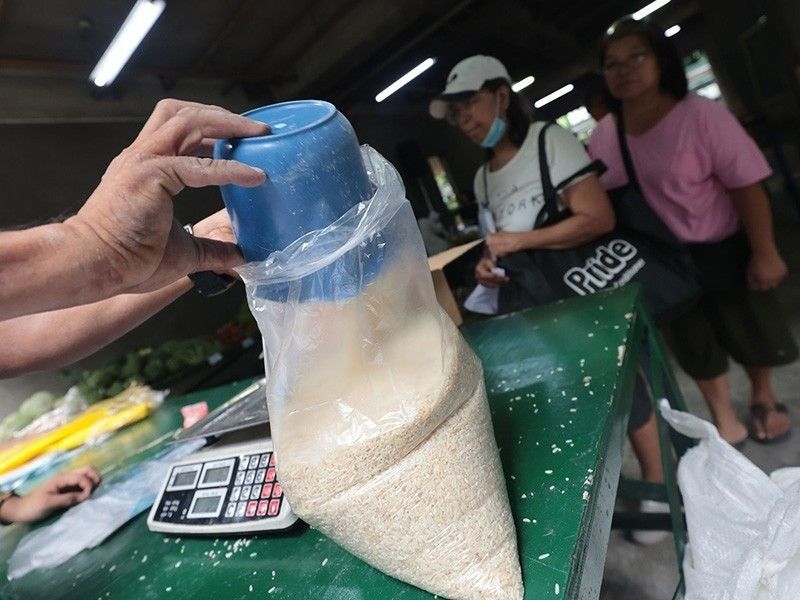Kadiwa stores' P42 per kilo of rice is unsustainable, says industry expert

MANILA, Philippines — The government’s sale of rice at P42 per kilogram in Kadiwa outlets for vulnerable populations is unsustainable, an agricultural association of farmers said.
Raul Montemayor, national manager of the Federation of Free Farmers Cooperative (FFF), said on Friday, November 29, that even Kadiwa outlets face limited supplies, often resulting in stock shortages.
“In one day, we consume about 35,000 tons... Ilan lang naman ang aabutin ng kadiwa outlets na 'yan (Those Kadiwa outlets can only cover so much),” he said in an interview with Super Radyo 594.
The Department of Agriculture plans to sell rice at P42 per kilogram at Kadiwa stores under its Rice-for-All program, which will cater to senior citizens, solo parents, persons with disabilities and members of the Pantawid Pamilyang Pilipino Program.
How many Kadiwa stores? The government is expecting 179 Kadiwa stores to be established nationwide by the end of 2024. It seeks to reach 300 by April or June 2025.
Agriculture Secretary Francisco Tiu Laurel Jr. said on Thursday, November 28, that he is coordinating with importers who promised to supply the rice at P42 per kilo.
To incentivize importers, its main source of rice supply for the program, the government issued Executive Order 62 in July 2024, reducing rice tariffs from 35% to 15%.
Despite this, Tiu Laurel said that retail prices remain high, adding that the wholesale price of imported rice is around P37 to P38 per kilogram.
Montemayor explained that farmgate prices of palay have been falling due to the influx of imported rice. He added that the wholesale price should only have a markup of P2 to P4 per kilogram when sold at retail in markets.
The cost of retail imported rice. The DA’s price monitoring showed that, from November 18 to 23, the price of imported commercial rice in Metro Manila markets ranged from P44.80 to P59.19 per kilogram, depending on quality.
Given these high prices, FFF suspects that retailers are “hitting the jackpot” by increasing rice prices by P10 to P20 per kilogram, while the government fails to address the issue.
RELATED: Is P42 per kilo of rice a fair price for farmers, consumers?
A band-aid solution
Montemayor said the DA’s statement seems like an “admission” that the lowering of tariffs was ineffective. This may explain why the government is now choosing to sell their own rice, he added.
“So kinekwestyon pa rin namin 'yung logic ng pagbaba nila ng tariff, nawalan tayo ng collection ng taripa at hindi naman bumaba ang presyo ng bigas,” the FFF national manager said.
(So we are still questioning the logic behind lowering the tariff. We lost tariff collections, yet the price of rice did not go down.)
The FFF believes that the P42 per kilogram price tag only worsens local farmers’ losses. Other peasant groups have also criticized the government’s priority over importing rice instead of local production.
Montemayor emphasized that the government’s plan to address the high cost of rice through Kadiwa stores is a facade to appear proactive, as it fails to resolve the issues of both rice prices and supply.
“‘Yung plano nila na magkalat ng P42 (per kilogram) is more for showing na may ginagawa ang gobyerno, pero it will not solve the problem dahil ang problema ng mataas na presyo ng bigas ay system-wide,” he said.
(Their plan to distribute rice at P42 per kilogram is more for showing that the government is taking action, but it will not solve the problem because the issue of high rice prices is systemic)
Let NFA regulate
Since the problem is systemic, Montemayor said the government should return the National Food Authority’s (NFA) power to regulate prices by distributing rice in markets. Selling their own rice at the Kadiwa centers won’t suffice.
“Hindi kayang sagutin ng pakikialam ng gobyerno unless ibalik nila 'yung dating NFA na talagang nagpapakalat ng bigas sa palengke,” he explained.
(The problem cannot be solved by the government’s intervention alone unless they restore the former NFA, which was responsible for distributing rice in the markets.)
He mentioned that the government has been importing "premium grade" rice, which is more expensive than other qualities of rice. It is also not affordable for the general public.
“Hindi naman sila umaangkat para sa masa (They’re not even importing for the masses),” Montemayor said.
The local commercial price of rice in Metro Manila markets is almost on par with imported rice, ranging from P43.35 to P59.86, depending on quality.
Meanwhile, the DA expects the country’s palay production to decline to 19.41 million metric tons in 2024, down from 20.06 million metric tons in 2023, due to the series of storms in November.
- Latest
- Trending






























